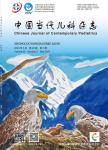Changes of Fibrinolysis and Their Relationship with Pulmonary Artery Pressures in Neonates with Lung Diseases
Changes of Fibrinolysis and Their Relationship with Pulmonary Artery Pressures in Neonates with Lung Diseases出 版 物:《中国当代儿科杂志》 (Chinese Journal of Contemporary Pediatrics)
年 卷 期:2002年第4期
页 面:339-341页
学科分类:1002[医学-临床医学] 100202[医学-儿科学] 10[医学]
主 题:Fibrinolysis Pulmonary artery pressure Lung disease Newborn
摘 要:Objective To study changes in plasma fibrinolysis and their relationship with pulmonary artery pressures in neonates with lung diseases. Methods Plasma activities of the tissue plasminogen activator (TPA) and tissue plasminogen activator inhibitor (PAI) were measured by chromogenic substrate methods in 27 newborns with lung diseases [10 with the respiratory distress syndrome (RDS), 12 with the meconium aspiration syndrome (MAS) and 5 with pneumonia] and in 25 normal newborns (controls). The ratio of the time of peak velocity (TPV) to the right ventricular ejection time (RVET) was determined using an Aloka SSD650 ultrasound system incorporating pulse waves to evaluate pulmonary artery pressures. Results PAI activity was significantly higher in infants with lung diseases [( 9.3 ± 4.1 ) AU×10 -1 /ml] than in the controls [( 5.5 ± 3.0 ) AU×10 -1 /ml] (P 0.01 ). The ratio of TPV to RVET was lower in the newborns with lung diseases ( 0.29 ± 0.05 ) than in the controls ( 0.34 ± 0.08 )(P 0.05 ). Elevated pulmonary artery pressures appeared to be involved in the fibrinolytic dysfunction in the infants with lung diseases. In 10 infants who developed pulmonary hemorrhage, TPA activity [( 1.8 ± 0.7 ) IU×10 -1 /ml)] and platelet counts [( 98 ±39)×10 9/L] in the acute phase of injury were significantly lower than those recorded during the recovery stage [( 3.7 ± 1.7 ) IU×10 -1 /ml and (180±30)×10 9/L, respectively] (P 0.01 ). Conclusions Following pulmonary hypertension, endothelial cell injury results in a lower release of TPA and increased PAI activity.



